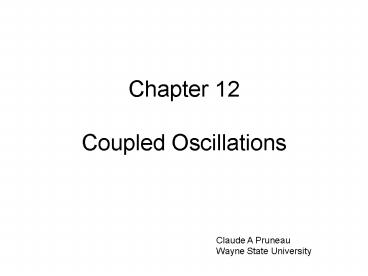Chapter 12 Coupled Oscillations - PowerPoint PPT Presentation
1 / 29
Title:
Chapter 12 Coupled Oscillations
Description:
Chapter 12 Coupled Oscillations Claude A Pruneau Wayne State University Chapter 12 Coupled Oscillations 12.1 Introduction Coupled equations Normal coordinates Normal ... – PowerPoint PPT presentation
Number of Views:400
Avg rating:3.0/5.0
Title: Chapter 12 Coupled Oscillations
1
Chapter 12Coupled Oscillations
Claude A Pruneau Wayne State University
2
- 12.1 Introduction
- Coupled equations
- Normal coordinates
- Normal modes
- n degrees of freedom (n-coupled 1-d oscillators
or n/3-coupled 3-d oscillators) leads to n normal
modes (in general) - some of the modes may be identical.
3
12.2 Two coupled harmonic oscillators. Example
In a solid, atoms interact by elastic forces and
oscillate about their equilibrium
positions. Lets consider the following simpler
system
m1M
m2M
?1?
?2?
?12
x2
x1
4
Consider a solution of the form
Frequency, ?, to be determined, and amplitudes
may be complex.
5
A solution to these Eqs exist if the 2x2
determinant is null.
This yields
6
There are two characteristic frequencies
The general solution is thus
7
The amplitudes are not all independent given that
they must satisfy.
The solutions may thus be written
8
There are four arbitrary constants - as expected
given one has two equations of second order.
9
add subtract
10
(No Transcript)
11
(No Transcript)
12
(No Transcript)
13
(No Transcript)
14
(No Transcript)
15
Weak Coupling
16
(No Transcript)
17
(No Transcript)
18
X1(t)
t
X2(t)
t
19
(No Transcript)
20
(No Transcript)
21
(No Transcript)
22
In general, we then find
where
By construction
23
In summary
24
finite
mij and Ajk express the coupling between the
various coordinates.
25
(No Transcript)
26
Euler-Lagrange Eq.
27
(No Transcript)
28
We get
A non trivial solution to this equation exists
only if
A secular Eq. of degree n in ?2. Implies n roots
for ?2
29
(No Transcript)

